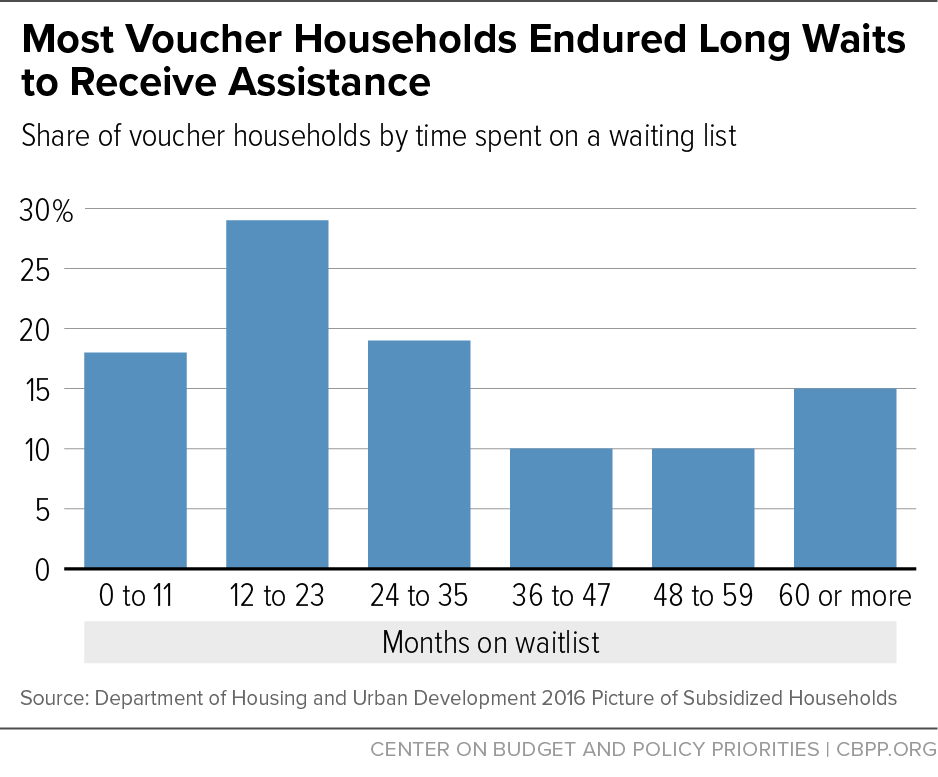BEYOND THE NUMBERS
Housing Vouchers Work: Huge Demand, Insufficient Funding for Housing Vouchers Means Long Waits
This is the next post in our “Housing Vouchers Work" blog series, which provides the latest facts and figures about the Housing Choice Voucher program, the largest rental assistance program to help families with children, working people, seniors, and people with disabilities afford decent, stable housing.
Housing vouchers help low-income households afford modest housing, but 3 in 4 needy renters don’t receive assistance due to funding limitations. Demand for vouchers is so high that a majority of housing agencies have closed their waiting lists, and agencies are often flooded with applications when waitlists reopen. Families that manage to get on a waitlist often wait years to receive a voucher. Surging demand and long waiting lists provide further evidence that the need for affordable housing far outstrips the supply — and that current federal voucher funding levels are inadequate to address the growing rental affordability crisis.
Many housing agencies close their voucher waitlists to new applicants, sometimes for years at a time, because applications significantly exceed available vouchers. When they reopen their lists, it is often for a short window, sometimes only a single day, as tens of thousands scramble to apply.
For example, Phoenix reopened its waiting list in August 2016 after being closed for 11 years. The city accepted an additional 10,000 applicants for just 6,800 total vouchers, only a small share of which become available each year to people waiting. Another 17,000 households that applied didn’t even get to put their names on the list. Houston received 68,000 applications for 30,000 open spots on the waitlist in October, and Chicago received 260,000 applications to a voucher waitlist capped at 45,000 names.
Almost 3 million families are currently waiting for a voucher, but over 9 million would be waiting if waiting lists had not been closed, the Public and Affordable Housing Research Corporation estimated in a 2017 report. Nearly all of those waiting are seniors, people with disabilities, or families with children.
Those lucky enough to get on the waiting list typically wait years to receive a voucher (see chart). Nearly half of all vouchers are administered by large housing agencies where the average wait time is over three years, according to our analysis of 2016 HUD data. In some small towns in Massachusetts, households wait up to ten years for a voucher. In Charlotte, North Carolina, 32,000 applicants were on the waitlist as of January 2015, but only 200-240 vouchers become available each year. Low-income renters who are currently on the Los Angeles waiting list will have a wait time of approximately 11 years, and that list has been closed since 2009.
Not everyone has an equal chance of getting a voucher. Over 60 percent of housing agencies — which administer 80 percent of all vouchers — use a preference system that allows them to target assistance. Housing agencies often prioritize the homeless, victims of domestic violence and natural disasters, local residents, veterans, and other groups. While this allows those most in need to skip the waiting list, it can mean that other households face even longer waits.
Voucher waitlists are a symptom of a larger problem: rental assistance funding falls far short of need. Unless funding is increased, millions — including children in their most formative years — will continue to spend years waiting for assistance, if they get it at all.

